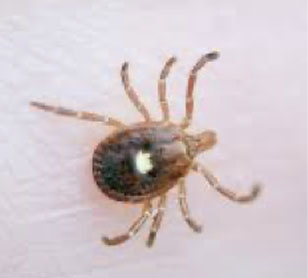News & Events
It's Tick Season
In his article on March 18, Jeff Burbrink, Purdue Extension Agent for Elkhart County, reported that ticks had been out in force for about a week stimulated by the warm weather. The predominant tick reported was a deer tick also known as a black-legged tick, Lyme disease tick, and bear tick. Also reported to him were the American Dog Tick and the Lone Star Tick.
 Deer Tick or Lyme Disease Tick
Deer Tick or Lyme Disease Tick
Significantly smaller than the more commonly encountered dog tick, adult female deer ticks are about as big as a sesame seed and have reddish hind bodies with black markings. Males are slightly smaller than females and are solid dark brown.
 Lone Star Tick
Lone Star Tick
Adult ticks have eight legs and are brown to tan. Females have a single silvery-white spot on its back while males have scattered spots or streaks around the margins of the body.
 American Dog Tick
American Dog Tick
Adults are oval and flattened in shape and are brown with whitish to gray markings. As larvae, they have six legs while nymphs and adults have eight. These extremities allow them to effectively crawl through their environment, as well as animal fur and human hair.
Vaccines
Mr. Burbrink reported that while your dog can get an annual vaccine, there is no longer a vaccine for humans on the market. For humans, covering your arms and legs and wearing repellents is advised. After being outdoors it is a good idea to check for ticks.
Removing a Tick
If you find a tick attached to you remove it carefully. The Center for Disease Control advises: “Use fine-tipped tweezers to grasp the tick as close to the skin's surface as possible. Pull upward with steady, even pressure. After removing the tick, thoroughly clean the bite area and your hands with rubbing alcohol or soap and water. Never crush a tick with your fingers. Dispose of a live tick by putting it in alcohol, placing it in a sealed bag/container, wrapping it tightly in tape, or flushing it down the toilet.”








